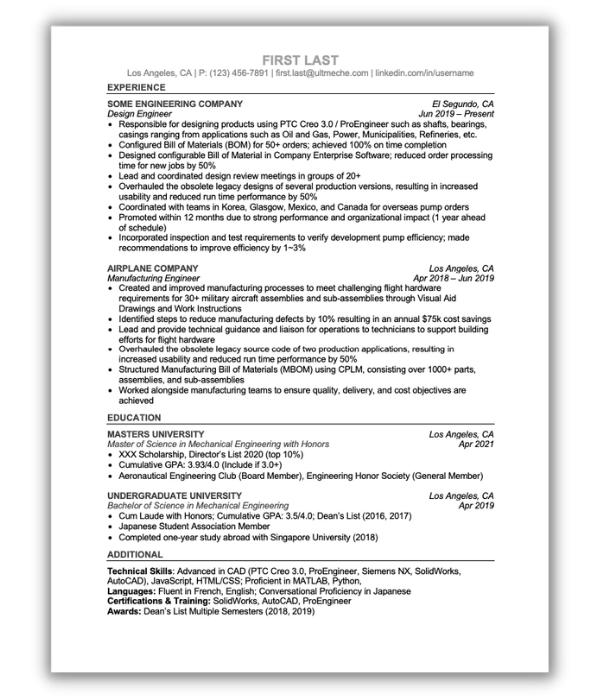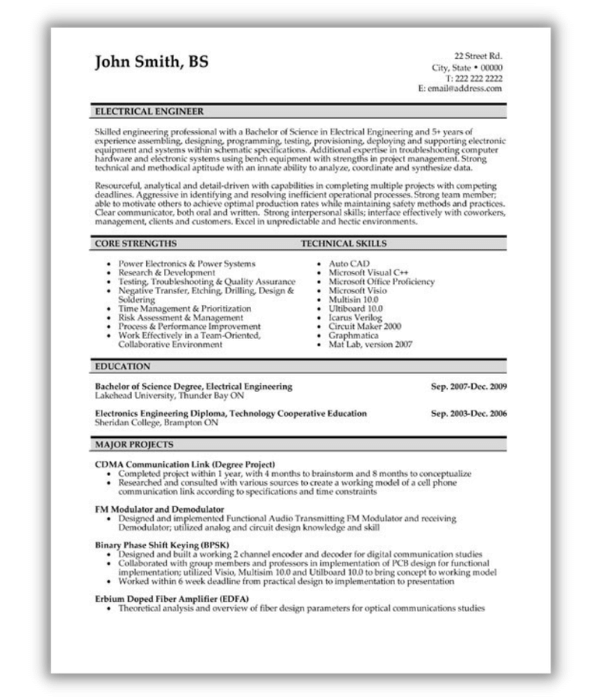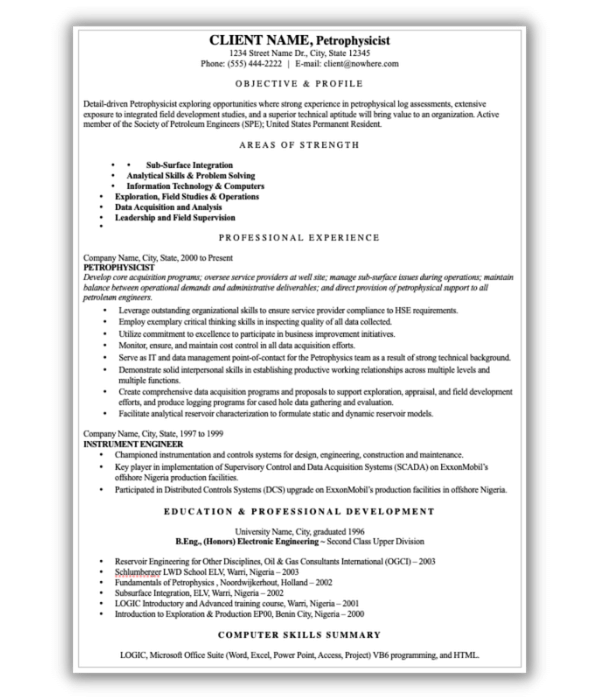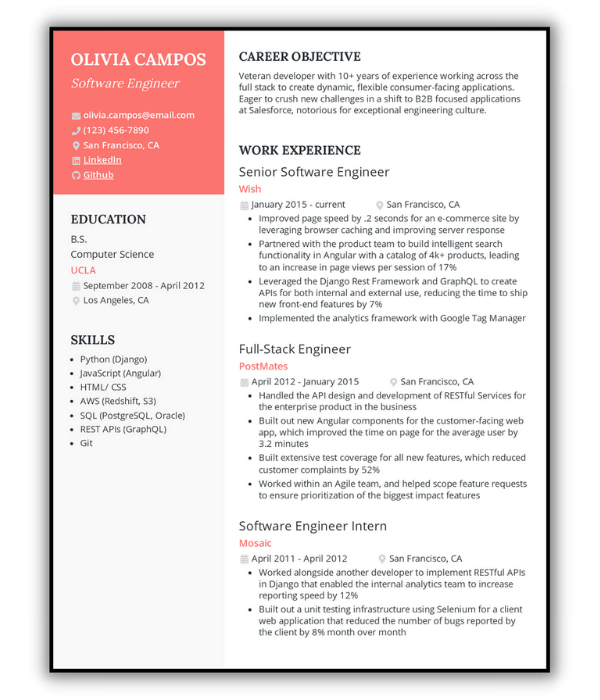How To Choose A Resume Format
February 29, 2024When there’s so many options, it’s difficult knowing how to choose a resume format. To know how to choose a resume format, you’re going to have to understand what a resume needs to consist of. Analysis paralysis is real. There’s way too much information out there, that it’s hard making a decision on which format to go with. We’re going to go over 5 different resume formats that have been shown to work.
If there was a gun held to our head and we could only pick one format?
We would pick Format 1. (See below)
Look at the formats below and use these resume formats for your job search.

There’s a saying that you’ll hear at one point in the industry:
“Keep it simple stupid.”
(KISS)
Engineers get way too complicated about things – from designing things, to holding meetings, to even their own resumes.
Below we’re covering both common resumes consisting of both simple and complex formats so you know how to choose a resume format.
What should a resume format consist of

Header
The header of your resume should consist of the following information:
- First Name Last Name
- City you’re based in
- Phone number
- Email address
- LinkedIn URL
It’s very standard across all resumes to include this.
Body
This is where resumes start to change a little bit.
Resume service providers will vary on what they include in their resumes, but use the below to figure out what to include at a minimum.
The body of your resume should consist of this at a minimum:
- Education
- Experience
- Additional
Why is the resume we recommend so simple? Because we keep it clear and concise. From a recruiter standpoint, this is what they want. They want to be able to quickly scan a resume to find keywords and skillsets.
Recruiters don’t want to read about how “you can work in a fast paced environment” or “have essential project management skills”.
They care about hard skills and hard accomplishments. No fluff.
Experience
Each section of the experience section in your resume should consist of:
- Employer
- City, ST
- Position Title
- Month Year from beginning – end of position
This is standard across all resumes. Make sure the resume you have contains these at a minimum.
Education
Each university or college info that is entered in your resume should consist of:
- University Name
- City, ST
- Degree Title
- Years of education / graduation year
Just like the experience section, the education section in your resume is standard and all formats should have this.
Additional
We capture everything else such as technical skills, certifications & training, and awards all in the Additional section of the resume. This is the best way to keep it clear and concise. You don’t need a bunch of tables, columns, or lists of skills in your resume. Catch your skills with a few lines in the Additional section in your resume.
Technical Skills
If you’re applying for technical roles, then you’re going to need the associated skills in your resume. No matter what your role is, there will be a certain set of skills that is required, so this is the section you will lay them out.
Additionally, the bullets that you use in your experience should contain these technical skills as well.
Certifications & Training
Certain jobs and positions will require specific certifications and training so you will need to include that information in your resume.
List certifications and training of the following items:
- Software
- Coursework
- Training sessions taken
- Project Management Professional
- Professional Engineering
The above will be some examples of what you can include in this.
Awards
The format you’re using should have room in there to detail awards and accomplishments.
Awards such as Dean’s Lists, Scholarships, and Employee spot awards are good examples
ATS Optimization
The resume that you use for job applications NEEDS to be ATS optimized.
What is ATS Optimization?
It’s ensuring that the resume format is written in an optimal manner such that the Applicant Tracking System (ATS) software picks up your resume.
What if the ATS doesn’t pick up my resume?
You’re not going to get a job and will stay broke.
Keywords
No matter the formatting, it’s important for your resume to contain keywords. Keywords are what the recruiter and ATS software will pick up on. Have enough of those in your resume? Congrats, you’re going to make more money.
5 Different Resume Formats You Can Choose
Now that we’ve covered what a resume should contain at minimum, we’ll show some resumes and detail how to choose a resume format. The resume you’re using should contain the above information. The formatting may differ between the resumes, but the use is still the same.
We’ll cover what looks good and what doesn’t look good.
Format 1

This is THE #1 best resume format we recommend.
It’s simple, clear and concise, displays keywords, metrics, and accomplishments.
The resume only consists of three sections:
- Education
- Experience
- Additional
This resume utilizes an Arial Font and standard borders, etc.
It also has all the information that we’ve outlined regarding how to choose a resume format.
Take a look at it and what do you see?
Pros:
Our first impressions of looking at this resume would be that:
- It’s clean
- Clear and concise wording
- Displays skills very clearly
- Easy for a recruiter to digest
Cons:
- It’s too simple
- No fancy formatting, tables, or colors
- Too much space in margins
- Many people use this style of resume
Although a lot of people do use this type of resume, this is still the most effective resume to use in our experience. We have landed clients many interviews and high paying jobs just using a simple format such as this. Don’t overcomplicate things.

Format 2
This is a format that I see amongst many of my clients. It’s also a pretty standard one.
It’s an electrical engineering resume that has the following sections:
- Summary
- Core Strengths
- Technical Skills
- Education
- Major Projects
As you can see, the resume is broken down into a header and body, as explained above.
Pros:
The resume cleanly separates the sections with a clean border, making it easy to scan. It’s a very straight to the point type of design.
This format is good for a student with no work experience, as stating projects on your resume is how you get your foot into the door.
Cons:
We feel that the summary section and core strength is just a lot of fluff. It’s redundant to have those sections, as your experience should speak for itself.
The format also looks “old-fashioned”, in our opinion.
The resume also doesn’t list out an experience section – either as a function of this being a student resume or just straight up not including experience.

Format 3
I also see this type of format very often with my clients.
The resume is broken up into the following sections:
- Objective & Profile
- Areas of Strength
- Professional Experience
- Education & Professional Development
- Computer Skills Summary
The resume also chooses to center align all of the text.
We don’t recommend this and recommend left aligning the main text (see Formats 1 & 2).
Pros:
Not too many pros here unfortunately. If your resume looks like this, you should have it re-written.
Cons:
There’s quite a few cons to list:
- Objective & Profile section is redundant
- Areas of strength is also redundant
- Center align is not a good use of space
- Experience aligned to the left and education aligned to the center shows inconsistency
- No border between section
- Cannot take a quick glance
So if your resume looks anything like this, you’re probably not getting any job interviews or calls back.
Do you see why now?
Format 4

This is way too over the top. Colors, gears, borders, etc. Your resume should not be this colorful. It should be plain and simple, not look like an art project.
And do you know what the best part is?
It’s not even one page.
There’s another page.
How is a recruiter going to quickly scan through 2 pages of something so condensed?
I’ve never seen a resume like this get passed to me for an interview. The resumes that all get interviews are all clear and concise.
Pros:
Visually, the concept is cool. Utilizing Gear logos for a Mechanical Engineering resume is creative.
It’s very visual and well designed from an image standpoint.
Cons:
However, there’s just too much going on and it makes it hard to quickly scan. Even looking at the gear logos will take away the 6 seconds a recruiter spends on your resume.
You want they keywords to be the first thing that pops out.
Just because a resume looks good doesn’t mean it’s going to get you through.
For what it’s worth, in my experience, a resume like this never gets through.

Format 5
This is another resume template that is also visual, but simple.
Clear and concise, displays quantitative results and accomplishments, and uses a more “modern” format.
Pros:
It’s very aesthetically pleasing, easy to look at, and very easy on the eyes.
The resume consists of everything necessary – Header, Body – Education, Experience, and Skills.
Overall, this resume seeks to catch high level accomplishments in work experience, which is the best approach to show your experience.
Cons:
There is a lot of empty space that could be better utilzed in the resume.
Also, the career objective is redundant – the work experience as a software engineer speaks for itself and captures that.
No need to point out that you have 10+ years of experience when taking a quick glance at the years of experience, you have 10+ years!
We really like this resume in terms of quality, we’ll put this just shy of Format 1.
We’ll say it over and over again – we recommend a simple, traditional format such as Format 1. No over the top colors, designs, borders, or images. Just clean text throughout the resume.
If you’re attempting to go the more modern route, use this template. The real money maker is going to be in that you capture high level accomplishments.
About the author

Kazuyoshi Fujimoto, PE
Founder | Engineering Career Coach | Principal Mechanical Engineer
Kazu oversees all of ultmeche’s engineering services. He provides consulting such as resume reviews, rewrites, mock interviews, and all services career related. Additionally, Kazu performs consulting work regarding Oil & Gas, Automotive, and Aerospace & Defense. Kazu is licensed as a professional engineer in the state of California and has 9+ years of experience in Oil & Gas, Automotive, and Aerospace & Defense.
Most importantly, he knows how to choose a resume format and keep things simple.
FAQ
Use Format 1. It’s very simple, has a modern element to it, and versatile. You can use it whether you’re in Engineering, Finance, Tech, HR, etc.
Yes that’s all a resume really needs.
No, your experience, education, and skills should speak for itself. If laid out in a clear and concise fashion, there’ s no need to state things twice.
Many resumes out there use “Objectives” and “Professional Summaries”, but it’s a waste of space because the same content will be in your resume already either in your skills or experience.
Save yourself the space and skip the objective & summary section on your resume.
Take your resume and upload it to an ATS simulator. There’s plenty you can search on google. You’ll need to upload the resume and make sure that the software will parse your resume. Once you’ve verified that, then the ATS software will also be able to pick up your resume.
Yes – simple is always best.
Do not go for complex, over the top, over designed resumes. They are inefficient and do not showcase your skillset and accomplishments as highly.
See our recent guide on what the different types of resume formats are.
We dive into 5 common resume formats, what each of them consist of, and what’s good or bad in a resume.
